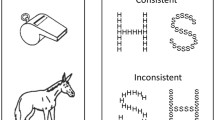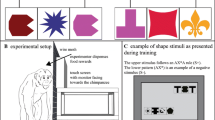Abstract.
This study was designed to examine whether chimpanzees and monkeys exhibit a global-to-local precedence in the processing of hierarchically organized compound stimuli, as has been reported for humans. Subjects were tested using a sequential matching-to-sample paradigm using stimuli that differed on the basis of their global configuration or local elements, or on both perceptual attributes. Although both species were able to discriminate stimuli on the basis of their global configuration or local elements, the chimpanzees exhibited a global-to-local processing strategy, whereas the rhesus monkeys exhibited a local-to-global processing strategy. The results suggest that perceptual and attentional mechanisms underlying information-processing strategies may account for differences in learning by primates.
Similar content being viewed by others
Author information
Authors and Affiliations
Additional information
Accepted after revision: 11 September 2001
Electronic Publication
Rights and permissions
About this article
Cite this article
Hopkins, W.D., Washburn, D.A. Matching visual stimuli on the basis of global and local features by chimpanzees (Pan troglodytes) and rhesus monkeys (Macaca mulatta). Anim.Cogn. 5, 27–31 (2002). https://doi.org/10.1007/s10071-001-0121-8
Received:
Published:
Issue Date:
DOI: https://doi.org/10.1007/s10071-001-0121-8




